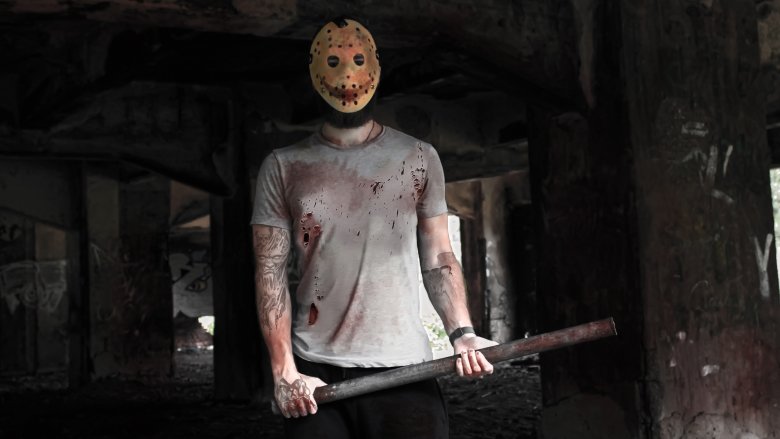Terrifying Serial Killers Still On The Loose
Serial killers are terrifying, just ask Hollywood. But what's extra-super terrifying is a serial killer who doesn't get caught. The FBI says there are between 25 and 50 active serial killers in the United States at any given time, and there probably isn't even a real Dexter trying to take them all out. So the best we can do is educate ourselves, avoid certain situations, and know which ones might be coming to get us. Good luck to us all.
The Original Night Stalker
If you're going to be a serial killer, you should have a slick name like "The Night Stalker." The name was so slick that some other serial killer copied it.
There were two serial killers called "The Night Stalker." Night Stalker II was Richard Ramirez, who killed 14 people in California in 1985 and liked to leave Satanic symbols at his crime scenes, just to make himself even more terrifying. Happily, he was apprehended with a year, and he died in prison in 2013 at the age of 53.
The Original Night Stalker, now called the Golden State Killer, was also operating in California — he is believed to have killed at least 12 people between 1976 and 1986 alone. According to the Sacramento Bee, he was fond of class rings and liked to steal them from his victims. He frequently tied his victims up before killing them, sometimes with intricate knots, and used a variety of murder weapons. The trail was cold for a long time, but in April 2018 Sacramento police arrested Joseph James DeAngelo, a former cop who still lived in the area where many of the crimes took place. CNN reported that DNA linked DeAngelo to several of the crimes, and in August Rolling Stone noted that he has been charged in connection with 13 rapes and 13 murders. If he's found guilty, this long nightmare might finally have some closure. Like all accused criminals in the U.S., DeAngelo is innocent until proven guilty.
The Colonial Parkway killer
If you've ever been on a road trip and late one night, you really, really had to pee, and you saw a rest stop and thought to yourself, "I'll just go there," don't. Use that empty Gatorade bottle instead. There's a reason that rest stop looks terrifying at night ... because it is.
According to the Huffington Post, between 1986 and 1989 a serial killer targeted couples traveling on Virginia's Colonial Parkway late at night. Okay, so most of the victims weren't attacked at rest stops, but they were all traveling on the scenic road that connects some of Virginia's most popular landmarks. Some of the victims' cars were abandoned with the driver's side windows rolled down and the glove boxes opened, as if the victims had been approached by someone they thought was law enforcement and they were getting ready to hand over their car's registration.
Eight people died along the Colonial Parkway, always in pairs and roughly one each year until the killings abruptly ended in 1989. And even though the FBI has a list of 130 suspects, it's still no closer to apprehending the Colonial Parkway killer.
The Monster of Florence
Let's just call him "Il Mostro di Firenze" because everything sounds less terrifying when you say it in Italian. This killer was active between 1974 and 1985, and he always targeted couples, though his motive and MO were extra-specially horrible: he killed only couples who were getting busy outside their homes — a common practice in Italy, where young people usually live with their parents until marriage. And because just killing people isn't horrible enough, he also mutilated the women's bodies, cutting off their genitals with a surgical precision that led police to suspect that he was someone with a medical background.
According to The Atlantic, more than 100,000 men were investigated in connection with the murders, which by the way is just over one quarter of the entire current population of Florence. It was the most expensive investigation in Italy's history, but police never closed the case. They made several arrests, but either had the wrong man or had captured a killer who was adept at escaping, murdering additional people, and then sneaking back into custody undetected.
The killings ceased in 1985, but that didn't end police obsession with the crimes. They were still arresting suspects in 2004 and were still coming up with wild theories, which usually included Satan worship because there always has to be Satan worship in there somewhere. (Thanks, Night Stalker II.) Despite all the effort, Il Mostro di Firenze has not been captured.
The Zodiac KIller
The Zodiac Killer is not only one of the most notorious serial killers of all time, he's also one of the most notorious serial killers who was never caught.
Active in California in the late '60s and early '70s, Zodiac got his name from ... himself, which is a seriously lame way to get an awesome serial killer name, but maybe he was just tired of waiting for the media to come up with something good. According to Bustle, the moniker first appeared in a letter he sent to a local newspaper, which also included a bunch of cryptograms that were supposed to reveal his identity, provided they could be deciphered.
Get ready because the Zodiac Killer's MO is going to seem eerily familiar: He targeted couples sitting in parked cars, so if that teaches you anything it's that you should never be a couple sitting in a parked car. Zodiac left a couple of survivors and witnesses who were able to describe him, but it wasn't enough for an arrest.
Zodiac enjoyed taunting police with letters detailing his crimes, but only five murders can be definitively attributed to him. He liked to claim there were many more, though — in one letter he wrote "Me = 37, SFPD = 0." Though a few suspects have emerged, no one knows for sure who the Zodiac really was or if he's still out there.
The I-70 killer
In April 1992, a 26-year-old clerk was shot to death in the Indianapolis store where she worked. Three days later, two female store clerks were shot at a Wichita, Kansas, bridal shop. Three weeks after that, the victim was the 24-year-old manager of a boot shop in St. Charles, Missouri. Each of the three crime scenes was in a different state, but they were all in shopping malls off Interstate 70. All the victims were murdered with the same gun, probably a semi-automatic .22-caliber pistol.
In May of that same year, the killer murdered a 37-year-old woman working at a gift shop in a mall. He'd also killed a 40-year-old man working at a ceramics store. In 1993 and 1994 there were three more murders in Texas, which police have also linked to the I-70 killer.
So besides the obvious lesson here, that you should never take a job as a store clerk at a shopping mall located just off Interstate 70, you should probably also not be a brunette female working as a store clerk at a shopping mall located just off Interstate 70. According to Vox Magazine, five of the first six victims were brunette women, and the sixth might have been mistaken for a woman because of his ponytail.
The killings stopped after 1994, but no one has ever been definitively identified as the I-70 killer.
The West Mesa Bone Collector
There are lots of very good reasons not to become a lady of the night, but one of the best is that they're often targeted by serial killers, mostly because they are less likely to be missed by friends and family. Also, going places with strange men is kind of a part of the job description.
According to the City of Albuquerque, that was pretty much the rough outline of the Bone Collector's plan — this modern serial killer buried at least 11 women and girls in a mesa on the outskirts of Albuquerque, New Mexico between 2001 and 2005. All but one of the victims was involved prostitution, and the one who wasn't was in the company of a person who was involved in prostitution. The remains of the 11 women (plus an unborn baby, for extra awfulness) weren't discovered until 2009, which means the killer either decided to give up his hobby or he moved away and set up serial killer shop somewhere else.
So don't sell yourself, don't work in a mall off Interstate 70, don't be a brunette, and don't kiss anyone in a parked car. That pretty much covers it. So far.
The Frankford Slasher
Between 1985 and 1990, someone raped and murdered nine women in Philadelphia, most of whom spent time in bars along Frankford Avenue. The really bizarre thing about this killer was his brazenness. According to CBS 3 in Philadelphia, he even rented an office in a church in order to establish himself as a professional counselor, though he stopped short of using a giveaway name like "Frank the problem slasher" or a catchy slogan like "I'll end your troubles ... for good."
The Frankford Slasher gained the trust of troubled bar patrons, and then took them out and killed them. Some of their bodies would turn up in apartments, while others were discarded in weird places like under a car or in a train yard.
Police had a suspect who abruptly moved away before an arrest could be made, and that person died a couple of years later. Of course that doesn't mean the case is closed — unless someone comes forward with damning evidence, the Frankford Slasher could still be on the prowl, or maybe sitting in his own little office in a church in your hometown. How's that for terrifying?
The February 9 killer
Between 2006 and 2008, Utah was home to a killer with a particularly bizarre MO — he would enter women's apartments and strangle them, but only on February 9. There were only two murders, which a crime lab linked using DNA evidence, but for at least a few years after the murders that February 9 date was enough to make people deadbolt their doors, or better yet, book a little February getaway to neighboring Moab for some sightseeing, hiking, and not getting killed-ing.
After the second murder the killer either lost his nerve or found a new hobby — police were on high alert and that might have been enough to convince him to not be a killer anymore, or at least to go to some other neighborhood and be a killer there. According to the FBI, there's really no way to know for sure — contrary to what you've probably heard, it's not always true that a serial killer will just keep on killing until being caught or dying. Some will find substitutions for murder and some just find it too difficult to keep up given the other stuff in their lives, you know, like hanging out with family and stamp collecting. So maybe the February 9 killer retired. Or maybe he didn't. Either way, it's probably not a bad idea to keep your doors locked on February 9, just in case.
Stoneman
Serial killers aren't just a product of Western culture and Showtime; they can lurk almost anywhere. In the mid- to late 1980s, a killer dubbed "Stoneman" was busy in urban India. His victims were homeless people sleeping alone on the streets, and his murder weapons were concrete blocks or stones, sometimes weighing up to 65 pounds, which he would use to crush his victims' heads. According to India TV, he killed 12 people in Mumbai between 1985 and 1988 and then moved to Calcutta, where he killed another 12 people in a single year, although police can't be sure the Calcutta murders were the work of the same person as the Mumbai murders — it's possible that a copycat took over where the original killer had left off.
It wasn't until the seventh victim died in Calcutta that police really started trying to find the killer — at one point they even disguised undercover agents as sleeping homeless people, which frankly sounds like the most terrifying assignment of all time.
The killings stopped after police started arresting people, but investigators were never able to prove the killer's identity, so all suspects had to be released. That might have been just enough to scare the Stoneman into retirement because he never struck again.
The flat tire murderer
Also known as the "Tooth Fairy Killer," which must have really annoyed him, the Flat Tire Murderer terrorized women in southern Florida for roughly one year, between February 1975 and January 1976. He typically posed as a good Samaritan, offering assistance to women with flat tires ... which he had deflated himself while their cars were parked in commercial parking lots. According to criminal profiler Chelsea Hoffman, once he gained his victims' trust, he killed them with a variety of different weapons: guns, hammer, ice-picks, and more. Some of the women were so badly beaten that they remain unidentified decades after the killer ended his terrifying spree.
Not to be confused with the Tooth Fairy Killer Francis Dolarhyde in the third season of Hannibal or The Tooth Fairy Killer that Dexter took out in Season 6, the Flat Tire Murderer earned the extra-special nickname "Tooth Fairy Killer" because he often pulled out his victims' teeth, presumably to stop police from identifying them.
Eerily, there were a bunch of similar murders from California to Massachusetts between 1971 and 1996, and no one can say for sure if the same killer was responsible. It could be that he's a really well-traveled killer or more likely, it could just be that it's insanely easy to kill people by flattening their tires and then offering to help. Either way, this is a pretty terrifying story that doesn't have an ending, and that sucks for everyone.
Hwaseong serial killer
In 1986 a woman was found dead in a rice field outside of Hwaseong City in South Korea. She'd been raped and strangled and bound with her own clothing. Not long after that, a second woman was found in pretty much the same state, and by 1991 the total number of victims was 10.
The investigation rivaled the Monster of Florence in its scale, with more than 20,000 suspects, 40,000 fingerprints, 570 DNA samples, and 180 hair samples. But after a 69-year-old woman was murdered in a similar way in 1991, the killer retired and the police were no closer to finding answers.
In an especially sucky twist, the law said that murderers in South Korea could only be prosecuted up to 15 years after the crime, and that 15-year window closed in 2006. But the statute of limitations for first-degree murder was extended to 25 years in 2007 and then abolished altogether in 2015, according to AFP. Thank goodness for progress.
Connecticut River Valley Killer
In 1997, a paraplegic named Gary Westover made a startling deathbed confession. Years earlier, he'd been forced to witness the abduction and murder of a woman in Vermont. He gave some details and the names of the murderers to his uncle, who dutifully handed the information over to law enforcement. Then law enforcement dropped the ball.
Westover and his uncle are both dead now, and no one can find the information that might have helped identify a serial killer, or in this case, serial killers. Called "The Connecticut River Valley Killer," this person or persons murdered at least seven people between 1978 and 1989. The women were stabbed to death, and their bodies were usually dumped in the woods.
According to the Tampa Bay Times, there are suspects — in particular, a man named Michael Nicholaou, who killed himself, his estranged wife, and his step-daughter in 2005. Nicholaou had been under some suspicion for the disappearance of his first wife in 1988. And the killer's last victim — the only one who survived — saw a photo of him and identified him as her attacker. But just like so many other cases of retired serial killers, there's really no way to know for sure. The only known piece of evidence that might definitively connect Nicholaou to the Connecticut River Valley killings is the one Gary Westover gave to the police — the one that no one can seem to find. Nice work, authorities.
The Honolulu Strangler
InfoBarrel calls this dude "Hawaii's first-ever serial killer," as if the accomplishment were on par with Hawaii's first-ever golf champion or its first-ever celebrity chef. It's frankly a pretty weird descriptor for a guy who kills people for fun, but okay. The Honolulu strangler killed at least five women between 1985 and 1986, and his MO was always exactly the same. He bound his victims' hands behind their backs, then raped and strangled them.
Here's what happened next: Police arrested a guy whose girlfriend and ex-wife both said he liked to tie their hands behind their backs while they would do the horizontal tango. Even more damning, the man's girlfriend told police that the murders occurred on nights when he'd gone out after a lover's quarrel.
The suspect even failed a polygraph test, but polygraphs aren't admissible evidence, so police had to let him go. And after that, the murders stopped. It's okay, though, if Hawaii is lucky maybe one day it'll get its "second-ever serial killer," which should be awesome for everyone, but not really.
So to sum up, don't sell yourself, don't work in a mall off Interstate 70, don't be a brunette, don't kiss anyone in a parked car, don't go anywhere with therapists you meet in bars, don't open your door on February 9, don't sleep on the streets of Calcutta, don't get a flat tire, and mostly just don't be female. That ought to protect you from becoming a serial killer's victim. But not really.



